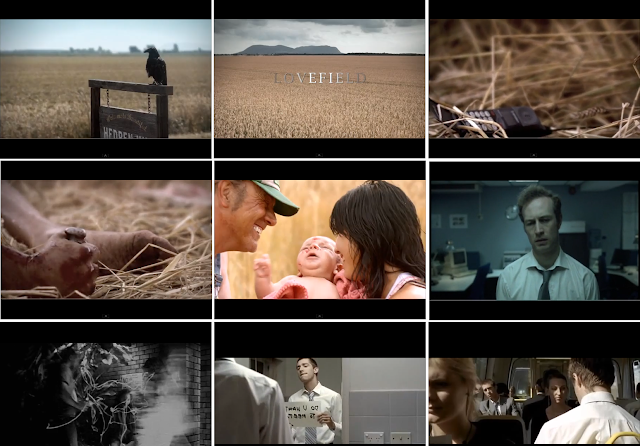Frame 1: A lot of our inspiration came from Lovefield by Mathieu Ratthe, including mise en scene and foli sounds. Lovefield leads viewers to think one thing until the very end and one method used that we included was the crow. The crow is often used in thriller and horror films as they are often associated with death and evil. Unfortunately we had neither a trained crow or very good nature skills. So we took the idea and developed it by adding non-diegetic sounds of a crow.
Frame 2: We also used Lovefields form for opening shots. Long, slow revealing shots of the setting to allow views to better understand the film.
Frame 3: A convention often used in thrillers are close ups of specific objects in a opening scene. Something both Lovefield and our film used after seeing the effectiveness of these close ups in Lovefield.
Frame 4: There were two things Lovefield did which we were really interested in doing. The unexpected twist (See frame 5) and sudden change in pace. In Lovefield a knife is suddenly plunged into the ground which is the sign for the sudden change. We developed this idea by having a hand suddenly land on a phone which is used for one of our opening shots.
Frame 5: The sudden twist in Lovefield is what really drew use to the film. It sort of adds a comedic value to the film as viewers just don't expect the ending and that's something we wanted to use and develop on in our film.
Frame 6: The short film The Black Hole uses colour effectively to effectively convey the mood of the character and we tried to use this in the end of our film after the body is discovered to try shift the mood and get the audience to really feel for our protagonist.
Frame 7: Two Cars One Night breaks the narrative of the film up by using sped up exposer shots of people moving about the parking lot. We wanted to use something similar to this for our 'cleaning up scene' and while we couldn't use exposer to create the trails of people moving like TCON we over-layed 3 shots to create a similar effect.
Frame 8: The last short film we used to help shape our film was Signs. The picture selected is actually out of a series of jump cuts used to show a lot of things in a short time. We defiantly used this convention to help us keep to our time limit and avoid audiences getting bored during the 'clean up scene' again.
Frame 9: Again, the picture here is not actually what we used to develop our film but it's the editing. The film often abruptly changes scene to shorten the film and is something used to have the same effect.
Question Two: How effective is the combination of your main product and your ancillary task?
Question Three: What have you learned from your audience feedback?
- How did we obtain our feedback?
- Feed back for our poster
I started my section of gaining audience feedback by uploading a final version of our film poster onto Facebook and asking for feedback (In return for a cookie) so we could see what our target audience thought needed improving to make them want to see the film. We got some positive feedback with a few suggestions for tweaking such as moving text off Jordan's hands and blurring the edges of Jordan.
- Feed back for our film
We then asked for feedback on our film. Again a lot of positive stuff, but the main complaint about the film was the fact that the phone says Dad on it, when in fact it's his Mum who rang. This was due to the fact that we were filming at my Dads house, so I rang the mobile from my Dads phone and didn't change his name in the phone book to 'Mum'.
But we also asked for feedback during the shooting and editing of our film. Especially with the opening shot where the logo appears. We originally had two different versions we were indecisive on so we asked our fellow class members which one they preferred, leading us to using the opening title you can see in the final film.
Conclusion: From our audience feedback we've learned to take a bit more time when setting up a shot to avoid silly little errors such as the name on the phone when it rings. We've also learned that if we really want to please our target audience we should involve them in the creating of the film to insure we get solid feedback
Question Four: How did you use new media technologies in the construction, research and planning and evaluation stage?



No comments:
Post a Comment